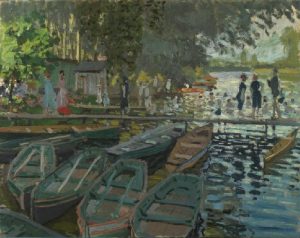During a recent trip to Trafalgar Square in Central London, I decided to check out the National Gallery. The gallery houses a collection of 2,300 paintings from the mid-13th century to the 20th, and was founded in 1824.
Whilst in the National Gallery I found myself surrounded by the impressionistic artists of the late 19th century. For the first time I noticed a few paintings that I hadn’t paid much detail too. This was the case when I came across ‘Bathers at La Grenouillere’ painted by Monet. Although I had seen the painting online when researching him in the past, I never really cared for the piece. However, seeing it within the gallery was a real eye-opener for me, and allowed me to see why it’s in the galleries top 30 highlighted paintings.
First thing I noticed was the scale of the piece. As mentioned, from seeing it prior to the gallery visit online, I imagined it to be bigger than what it was (73 x 92cm). upon reflection however, many of Monet’s works were around this size. From being within the gallery seeing the painting first hand, it put everything back in to proportion to me. This almost forced me to get close to the painting to appreciate it. Once doing this, I noticed how free-flowing this piece was compared to some of his other paintings. Upon looking at the piece once more online, I’ve discovered it says;
“The exceptionally free handling of Monet’s painting may in part be due to the canvas being a sketch for what was to be a more ambitious composition painted back in the studio.” (1)
This stuck out to me because although the piece is highly praised within the gallery, it isn’t the traditional way Monet created his paintings. The artist is famous for painting in a ‘Plein Air’ (the act of painting outdoors) style, which contradicts how Bathers at La Grenouillere was created. This is something I may have not noticed or pondered upon if I didn’t see the painting first hand.
Bibliography
(1) https://www.nationalgallery.org.uk/paintings/claude-monet-bathers-at-la-grenouillere

